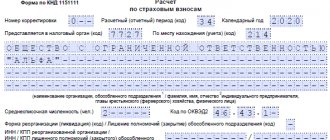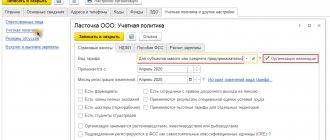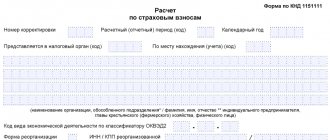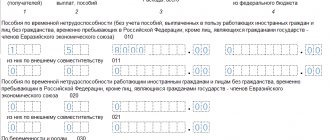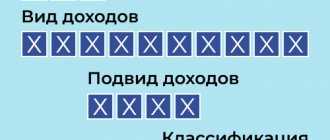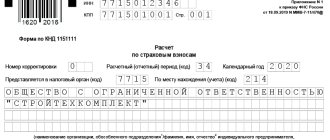To whom and where to submit reports on contributions
The functions of insurers for compulsory social insurance are assigned to employers (organizations, individual entrepreneurs, ordinary individuals without entrepreneurial status) who enter into employment contracts or civil contracts with individuals and pay them remuneration.
When calculating benefits, policyholders must calculate insurance premiums from them, pay these premiums, and then report them to regulatory authorities. Organizations are required to submit reporting forms for insurance premiums, regardless of whether income was paid to individuals or not. That is, if there are no payments, zero reports are submitted.
The situation is different with individual entrepreneurs - an individual entrepreneur who is not registered as an employer without employees does not submit reports on insurance premiums.
There are different types of contributions:
- for insurance against temporary disability and in connection with maternity (VNiM);
- compulsory pension insurance (OPI);
- compulsory health insurance (CHI);
- insurance against accidents at work and occupational diseases (insurance and occupational diseases).
The first three types are administered by the tax service, the fourth by the Social Insurance Fund. But for all types, the reporting periods are: quarter, half-year, 9 months. The billing period is one year. After the completion of each of these periods, inspectors must be presented with reports on the basis from which contributions were calculated and in what amount, as well as which payments were not subject to taxation.
Appendix No. 2 to section 1
Appendix 2 to Section 1 calculates the amount of contributions for temporary disability and in connection with maternity. The data is shown in the following context: total from the beginning of 2021 to June 30, as well as for April, May and June 2021.
In field 001 of Appendix No. 2, you must indicate the sign of insurance payments for compulsory social insurance in case of temporary disability and in connection with maternity:
- “1” – direct payments of insurance coverage (if there is a FSS pilot project in the region, See “Participants in the FSS pilot project”);
- “2” – offset system of insurance payments (when the employer pays benefits and then receives the necessary compensation (or offset) from the Social Insurance Fund).
Next, we will explain filling out the lines with decoding:
- line 010 – total number of insured persons in the first half of 2021;
- line 020 – amounts of payments in favor of the insured persons. Payments that are not subject to insurance premiums are not shown in this line;
- line 030 summarizes: the amount of payments not subject to insurance contributions for compulsory social insurance (Article 422 of the Tax Code of the Russian Federation);
- the amount of expenses that the contractor has documented, for example, under copyright contracts (clause 8 of Article 421 of the Tax Code of the Russian Federation). If there are no documents, then the amount of the deduction is fixed in the amount specified in paragraph 9 of Article 421 of the Tax Code of the Russian Federation;
On line 050 - show the basis for calculating insurance contributions for compulsory social insurance.
Line 051 includes the base for calculating insurance premiums from payments in favor of employees who have the right to engage in pharmaceutical activities or are admitted to it (if they have the appropriate license). If there are no such employees, enter zeros.
Line 053 is filled in by individual entrepreneurs who apply the patent taxation system and make payments in favor of employees (with the exception of individual entrepreneurs who conduct activities specified in subclause 19, 45–48 clause 2 of article 346.43 of the Tax Code of the Russian Federation) - (subclause 9 p 1 Article 427 of the Tax Code of the Russian Federation). If there is no data, then enter zeros.
Line 054 is filled out by organizations and individual entrepreneurs that pay income to foreigners temporarily staying in Russia. This line requires showing the basis for calculating insurance premiums in terms of payments in favor of such employees (except for citizens from the EAEU). If there is nothing like that - zeros.
On line 060 - enter insurance contributions for compulsory social insurance. Line 070 – expenses for the payment of insurance coverage for compulsory social insurance, which is paid at the expense of the Social Insurance Fund. However, do not include benefits for the first three days of illness here (letter of the Federal Tax Service of Russia dated December 28, 2016 No. PA-4-11/25227). As for line 080, show in it the amounts that the Social Insurance Fund reimbursed for sick leave, maternity benefits and other social benefits.
Show in line 080 only amounts reimbursed from the Social Insurance Fund in 2017. Even if they concern 2021.
As for line 090, it is logical to use the formula to determine the value of this line:
If you have received the amount of contributions to be paid, enter code “1” in line 090. If the amount of expenses incurred turned out to be more than accrued contributions, then include code “2” in line 90.
Appendix 3 to section 1: expenses for compulsory social insurance
In Appendix 3 to Section 1, you need to record information about expenses for the purposes of compulsory social insurance (if there is no such information, then the Appendix is not filled out, since it is not mandatory). As for the actual filling, the lines need to be formed like this:
- on lines 010–090 - indicate the number of cases of payments, the number of days paid, as well as the amount of expenses incurred)
- on line 100 – the total amount of social insurance expenses for all types of payments is entered.
Annexes 2, 3, 4 for pilot project participants
Participants in the Russian FSS pilot project (with code "1" in field 001) must summarize lines 070 and 080 in Appendix 2. As a rule, they must enter the values "0". As for Annexes 3 and 4, there is no need to show anything in them, since participants in the pilot project do not pay employee benefits. This is done directly by the FSS.
What form should you use to report to the Social Insurance Fund in 2021?
For contributions from accidents and occupational diseases, a report is submitted to the Social Insurance Fund. The 4-FSS form, valid in 2020-2021, was approved by Order No. 381 of the FSS of the Russian Federation dated September 26, 2016, and was last edited in 2021 (Order No. 275 of June 7, 2017).
The report states:
- On the title page - information about the policyholder: his name, TIN, registration number in the Social Insurance Fund, contact details, information about the reporting period - reporting period number and year. The title card is certified by an authorized person and a seal (if any).
- Table 1 shows the basis for calculating contributions; amounts not subject to taxation; tariff rate, which is set depending on the type of activity performed at the beginning of each year based on the results of the previous year.
- Table 2 shows calculations for contributions, including the balance of debt owed to the fund or to it; the amount of accruals on contributions for the reporting period, including for the last three months of the reporting period; transferred contributions with details of payment orders; the amount of expenses reimbursed by the fund and not accepted for offset. Based on all this data, the balance of debt owed to or behind the fund is displayed.
- Table 5 contains data on the special assessment of working conditions and medical examinations.
The listed parts of the report must be submitted even if there is no data to fill out. In this case, all empty columns are crossed out.
Tables 1.1 (on the calculation of contributions from payments to outsourced employees), 3 (on costs associated with industrial accidents), 4 (on the number of victims) are included in the calculation only upon the occurrence of the events noted in them - transfer of personnel or accidents .
You can see samples of filling out Form 4-FSS for different reporting periods, as well as a line-by-line algorithm for filling out a report in ConsultantPlus. If you do not have access to this legal system, a full access trial is available for free online.
Main innovations in the form of DAM
The updated form appeared for several reasons. The main one is the amendments made to the Tax Code.
Firstly, starting from 2021, the DAM includes data on the average number of employees. They are reflected on the title page. This is due to the fact that the self-report with this information has been cancelled.
Secondly, in 2021 a number of insurance premium rates were changed. For small and medium-sized businesses, the aggregate rate was reduced by half. For those areas that suffered the most from the coronavirus crisis, zero insurance premium rates were in effect in the first half of 2020.
In this regard, the tax service previously recommended indicating new payer tariff codes in the DAM form: 20 – for SMEs; 21 – for those that belong to the most affected industries; 22 – for electronics / radio electronics developers.
In addition, to reflect in section 3 of the KND form 1151111, new codes for insured persons were introduced, corresponding to payer tariff codes 20-22:
- MS. Serves to indicate the portion of the payment exceeding the minimum wage to an employee of a small or medium-sized enterprise;
- KV. Used to reflect payments from which insurance premiums were calculated at a zero rate;
- ECB. Used to reflect employer payments related to IT/electronics development.
The above changes must be taken into account when filling out the DAM for the 4th quarter of 2021.
Another innovation: from 14% to 7.6%, tariffs for calculating contributions for employee insurance for organizations in the field of high technology and electronics development were reduced. For this category of payers, the new DAM form contains a separate section - Appendix 5.1.
When to submit a report to social security
For 4-FSS, submission deadlines vary depending on the method of submitting the calculation.
If it is submitted on paper (this option is available to employers whose average number of employees over the past year did not exceed 25 people), then the report must be submitted no later than the 20th day of the month following the reporting period. That is, for the reporting periods of 2021, the due dates were April 20, July 20, October 20, 2021 and January 20, 2021 for the annual report for 2021. For the periods of 2021 - April 20, July 20, October 20, 2021 year and January 20, 2022 - for the annual report for 2021.
Be more careful with deadlines if they fall on weekends, since Law No. 125-FZ, unlike the Tax Code, does not clearly stipulate the rules for postponement. Although the FSS is loyal in this matter and allows the transfer.
The paper report can be personally brought to the territorial body of the Social Insurance Fund at the place of registration, submitted through an authorized representative, having previously written out a power of attorney for it, or sent by Russian Post with a list of the contents.
If the report is submitted electronically (those persons whose SSC/number of employees exceeds 25 people are required to report this way), then the deadlines are extended by 5 additional days. Taking into account the “exit” transfer allowed by the Social Insurance Fund in 2021, we reported until April 27, July 27, October 26, 2021 and January 25, 2021 - according to the annual report for 2021; in 2021 - until April 26, July 26, October 25, 2021 and January 25, 2022 - according to the annual report for 2021.
We described how to submit an electronic version of the report here.
In what form is the report on insurance premiums for 2020-2021 submitted to the Federal Tax Service?
Reporting on insurance premiums for compulsory medical insurance, compulsory medical insurance and VNiM this and next year is carried out on an updated form. Starting with the reporting campaign for 2021, a new form is used, as amended by Order of the Federal Tax Service of Russia dated October 15, 2020 No. ED-7-11/ [email protected]
ConsultantPlus experts explained in detail what changes have been made to the form. Get free demo access to K+ and go to the review material to find out all the details of the innovations.
A single calculation consists of a title page, three sections and appendices to them. Let us briefly describe them:
- The title book is filled with information about the policyholder, the tax authority, and the reporting period. Always presented, even if the calculation is zero.
- Section 1 provides summary data on the obligations of the reporting entity - the total amount of accruals for each type of contribution and broken down monthly for the last three months of the reporting period. There are 9 appendices to this section, which provide calculations for contributions to compulsory health insurance, compulsory medical insurance, VNiM, for additional social security for certain categories of insured persons, calculations of compliance with the conditions for applying the reduced rate of insurance premiums; insurance costs for VNiM and payments made from federal budget funds are reflected. Each appendix is included in the report if there is data to fill it out; if there is none, only section 1 itself is presented.
- Section 2 is a summary of the obligations of heads of peasant farms. Appendix 1 provides a calculation of such obligations. Subject to surrender by the relevant types of insureds.
- Section 3 with personalized information about the insured persons consists of two subsections: 3.2.1 - filled out and submitted by all policyholders, 3.2.2 - only by those who make payments subject to additional tariff contributions.
You will find samples of filling out the ERSV for different reporting periods, as well as a line-by-line algorithm for filling out the report in ConsultantPlus, having received free trial access.
Codes for RSV sections
In the remaining sections, the codes indicated do not relate to general information, but are related to payments of contributions.
KBK
The policyholder enters budget classification codes in accordance with Order of the Ministry of Finance dated May 12, 2020 N 86n. In 2021, the same 20-digit codes are used for contributions as in 2021. The company indicates the same values in field 104 of payment documents. We talked about the KBK for 2021 in this article.
OKTMO
OKTMO is assigned to the territory. In fact, this is a link to the municipality - city, village, etc., where the company is located. You can clarify the OKTMO of your company with your Federal Tax Service or using ]]>Federal Tax Service]]>.
Payer type
The type of contribution payer is indicated so that the Federal Tax Service can divide those reporting into those who paid funds to individuals in the last 3 months of the reporting period (code “1”), and those who did not make payments to citizens (code “2”). If the company did not transfer wages or pay under GPC agreements, it can submit a shortened version of the calculation (clause 4.2 of Appendix 2 to the order), consisting of:
- title page;
- section 1 without appendices;
- section 3.
Employers who paid employees during the reporting period submit their reports in full.
Tariff code in RSV
The state provided benefits to a certain circle of payers in the form of a reduced contribution rate (Article 427 of the Tax Code of the Russian Federation). The payer code in the DAM shows whether the company enjoys the right to reduced contributions or not. Some benefits have already been canceled in 2021 and are no longer valid, so the tariff codes in the DAM for 2021 have been revised.
Updated: New tariff code in the RSV from the 2nd quarter of 2020
All approved values are shown in Table 4.
Table 4. Tariff code
| Code | Payers of insurance premiums |
| 01 | Applying the basic tariff of insurance premiums |
| 06 | Carrying out activities in the field of information technology |
| 07 | Making payments to crew members of ships registered in the Russian International Register of Ships for the performance of labor duties of a ship crew member |
| 10 | NPOs (with the exception of state (municipal) institutions) applying the simplified tax system and carrying out, in accordance with the constituent documents, activities in the field of social services for the population, scientific research and development, education, healthcare, culture and art (the activities of theaters, libraries, museums and archives) and mass sports (except professional) |
| 11 | Charitable organizations registered in accordance with the procedure established in the Russian Federation and using the simplified tax system |
| 13 | Project participants in accordance with the law of September 28, 2010 No. 244-FZ “On innovation” or in accordance with the law of July 29, 2017 No. 216-FZ “On innovative scientific and technological centers and on amendments to certain legislative acts of the Russian Federation” |
| 14 | Participants in the free economic zone in accordance with the law of November 29, 2014 No. 377-FZ “On the development of the Republic of Crimea and the federal city of Sevastopol and the free economic zone in the territories of the Republic of Crimea and the federal city of Sevastopol” |
| 15 | Residents of the territory of rapid socio-economic development in accordance with the law of December 29, 2014 No. 473-FZ |
| 16 | Residents of the free port of Vladivostok in accordance with the law of July 13, 2015 No. 212-FZ |
| 17 | Resident organizations of the Special Economic Zone in the Kaliningrad region in accordance with the law of January 10, 2006 No. 16-FZ |
| 18 | Russian organizations engaged in the production and sale of animated audiovisual products produced by them, regardless of the type of contract and (or) provision of services (performance of work) for the creation of animated audiovisual products |
| 19 | Participants in the special administrative region in accordance with the law of 03.08.2018 No. 291-FZ “On special administrative regions in the territories of the Kaliningrad region and Primorsky Krai”, making payments and other rewards to crew members of ships registered in the Russian Open Register of Ships for the performance of labor duties crew member |
If in the billing period the payer had more than one tariff, then he must fill out as many appendices 1 to section 1 of the Calculation as he has applied tariffs (clause 5.4 of the Procedure).
An error in the encoding may result in the Federal Tax Service asking for clarification - the company must confirm its right to apply preferential tariffs.
Tariff code in DAM 2021 under simplified tax system
“Simplers” are excluded from the list of persons enjoying benefits when calculating contributions. They use the same tariff code for the simplified tax system when calculating insurance premiums as other organizations and individual entrepreneurs who use the basic tariff - “01”. Insurers on UTII also calculate premiums at the general rate, so the specified coding also applies to them.
The codes in subsections 1.3.1, 1.3.2, 1.1 are associated with special assessment and working conditions recognized as harmful or difficult. The values of the indicators are given on the form itself, so they do not require additional decoding.
Document type code
The code is indicated to identify a citizen and is used to check data on an individual. The accepted values are shown in Table 5.
Table 5. Types of documents
| Code | Title of the document |
| 21 | Passport of a citizen of the Russian Federation |
| 03 | Birth certificate |
| 07 | Military ID |
| 08 | Temporary certificate issued in lieu of a military ID |
| 10 | Foreign citizen's passport |
| 11 | Certificate of consideration of an application for recognition of a person as a refugee on the territory of the Russian Federation on the merits |
| 12 | Residence permit in the Russian Federation |
| 13 | Refugee ID |
| 14 | Temporary identity card of a citizen of the Russian Federation |
| 15 | Temporary residence permit in the Russian Federation |
| 18 | Certificate of provision of temporary asylum on the territory of the Russian Federation |
| 23 | Birth certificate issued by an authorized body of a foreign state |
| 24 | Identity card of a Russian military personnel |
| 91 | Other documents recognized in accordance with the legislation of the Russian Federation or in accordance with international treaties of the Russian Federation as identity documents |
Insured category code
The category of the insured person in section 3 on persuance reflects the working conditions and attitude towards Russian citizenship. The amount of contributions depends on the selected category.
Updated: New category codes for the insured person in the DAM 2020
Accepted code values are listed in Table 6.
Table 6. Codes of the category of insured persons
| Code | Name |
| HP | Persons covered by compulsory health insurance, including those working under special (difficult and harmful) working conditions, for whom contributions are paid at the basic rate |
| ODIT | Individuals for whom contributions are calculated for organizations operating in the field of information technology |
| ICS | Individuals for whom contributions are calculated by organizations participating in the Skolkovo project or project participants in accordance with Law No. 216-FZ dated July 29, 2017 |
| ASB | Individuals to whom contributions are calculated: — non-profit organizations (except for state/municipal institutions) that apply the simplified tax system and carry out, in accordance with the constituent documents, activities in the field of social services for the population, scientific research and development, education, healthcare, culture and art and mass sports; — charitable organizations registered in accordance with the procedure established by the legislation of the Russian Federation and applying the simplified tax system |
| BSEC | Individuals - crew members of ships registered in the Russian International Register of Ships, receiving payments and other rewards for performing the duties of a ship crew member |
| Cattle | Individuals for whom contributions are calculated by payers participating in the free economic zone in accordance with the law of November 29, 2014 No. 377-FZ (Crimea and Sevastopol) |
| TOP | Individuals for whom contributions are calculated by resident payers of the territory of rapid socio-economic development in the Russian Federation in accordance with Law No. 473-FZ dated December 29, 2014 |
| SPVL | Individuals for whom contributions are calculated by resident payers of the free port of Vladivostok |
| KLN | Individuals for whom contributions are calculated by payers included in the register of residents of the Special Economic Zone in the Kaliningrad Region |
| ASM | Individuals for whom contributions are calculated by organizations engaged in the production and sale of animated audiovisual products produced by them, regardless of the type of contract and (or) provision of services (performance of work) for the creation of animated audiovisual products |
| SAR | Individuals for whom contributions are calculated for the performance of labor duties of a ship crew member by payers participating in the special administrative region in accordance with Law No. 291-FZ dated August 3, 2021 |
| VZHNR | Foreign citizens or stateless persons insured in the OPS system, temporarily residing in the territory of the Russian Federation, as well as persons temporarily staying in the Russian Federation who have been granted temporary asylum under Law No. 4528-1 of February 19, 1993 |
| For foreign citizens or stateless persons insured in the OPS system, temporarily residing in the territory of the Russian Federation, as well as persons temporarily staying in the Russian Federation who were granted temporary asylum under Law No. 4528-1 of February 19, 1993: | |
| VZHIT | to which contributions are calculated by organizations operating in the field of information technology |
| VZhTS | by which contributions are calculated by organizations participating in the Skolkovo project or by project participants in accordance with Law No. 216-FZ dated July 29, 2017 |
| VZSB | for which contributions are calculated: — NPOs (with the exception of state (municipal) institutions) that apply the simplified tax system and carry out, in accordance with the constituent documents, activities in the field of social services for the population, scientific research and development, education, healthcare, culture and art and mass sports; -charitable organizations registered in accordance with the procedure established by the legislation of the Russian Federation and applying the simplified tax system |
| VZhES | crew members of ships registered in the Russian International Register of Ships, receiving payments and rewards for performing the duties of a ship crew member |
| VZhKS | for which contributions are paid by payers participating in the free economic zone according to the law of November 29, 2014 No. 377-FZ (Crimea and Sevastopol) |
| VZhTR | for which contributions are paid by taxpayers-residents of the territory of rapid socio-economic development in the Russian Federation |
| VZHVL | for which fees are paid by resident payers of the free port of Vladivostok |
| VZHKL | for which contributions are paid by resident payers of the Special Economic Zone in the Kaliningrad Region |
| VZHAN | for which contributions are paid by organizations engaged in the production and sale of animated audiovisual products produced by them, regardless of the type of contract and (or) provision of services (performance of work) for the creation of animated audiovisual products |
| VZHAR | from payments and remunerations from which contributions for the performance of the duties of a ship crew member are calculated by payers-participants of the special administrative region, respectively. with the law of August 3, 2018 No. 291-FZ |
| VPNR | Foreign citizens or stateless persons (with the exception of highly qualified specialists) in accordance with the law of July 25, 2002 No. 115-FZ |
| For foreign citizens or stateless persons (except for highly qualified specialists) in accordance with the law of July 25, 2002 No. 115-FZ: | |
| VPIT | according to which contributions are calculated by organizations operating in the field of information technology |
| VPCS | for which contributions are calculated by organizations participating in the Skolkovo project or project participants in accordance with Law No. 216-FZ dated July 29, 2017 |
| VPSB | for which contributions are paid: — NPOs on the simplified tax system and carrying out, in accordance with the constituent documents, activities in the field of social services for the population, scientific research and development, education, healthcare, culture and art and mass sports; charitable organizations on the simplified tax system |
| VPES | crew members of ships registered in the Russian International Register of Ships, receiving payments and other rewards for performing the duties of a ship crew member |
| VPKS | According to which insurance premiums are calculated by payers who are participants in the free economic zone of Crimea and the city of Sevastopol |
| VPTR | according to which contributions are calculated by payers-residents of the territory of rapid socio-economic development in the Russian Federation |
| VPVL | according to which contributions are calculated by payers-residents of the free port of Vladivostok |
| VPKL | According to which contributions are calculated by resident payers of the Special Economic Zone in the Kaliningrad Region |
| VPAN | for which contributions are calculated by organizations engaged in the production and sale of animated audiovisual products produced by them, regardless of the type of contract and (or) provision of services (performance of work) for the creation of animated audiovisual products |
| VPAR | for which contributions for the performance of the duties of a ship crew member are calculated by payers-participants of the special administrative region in accordance with Law No. 291-FZ dated August 3, 2018 |
Insured person code
In the RSV, the code of the insured person is linked to the results of the special assessment; it shows to which hazard class the workplace where the employee who received the payments worked was assigned. The code is closely related to the appointment of early pensions; The submitted information will be reflected in the personal accounts of employees.
All encodings are listed in Table 7.
What are the deadlines and methods for submitting 2020-2021 reports on insurance contributions to the tax office?
Policyholders submit a single calculation of contributions to the tax office by the 30th day of the month following each reporting period.
In 2021:
- until February 1 - for 2021 (postponed from Saturday January 30);
- until April 30 - for the 1st quarter of 2021;
- until July 30 - for half a year;
- until November 1 - 9 months in advance (postponed from Saturday October 30).
Note! Separate deadlines are set for heads of peasant farms without employees. They report once a year until January 30th.
The deadline for submitting reports on insurance premiums to tax authorities does not depend on the method of presentation. You can also submit it on paper or electronically. Moreover, the requirement to submit a paper report is much stricter here than for 4-FSS. This requirement has been in effect since 2021 and implies that the insured’s social capital (or the number of employees for newly created organizations and individual entrepreneurs) does not exceed 10 people. Employers with larger numbers are required to report exclusively electronically.
How to fill out a half-year calculation
Most policyholders will fill out insurance premium calculations for the 2nd quarter of 2021 electronically using special accounting software services (for example, 1C). In this case, the calculation is generated automatically based on the data that the accountant enters into the program. However, in our opinion, it is advisable to understand some principles of calculation formation in order to avoid mistakes. We will comment on the features of filling out the most common sections, and also provide examples and samples.
How to punish for violating deadlines for submitting reports on insurance contributions to extra-budgetary funds
Reporting on insurance premiums to both the Social Insurance Fund and the tax office is submitted within the strictly allotted time frame. All delays are fraught with fines.
The policyholder who did not submit the 4-FSS calculation to the FSS on time will be punished under clause 1 of Art. 26.30 of Law No. 125-FZ. The fine is calculated as 5 percent of the amount of contributions payable for the last three months of the reporting (calculation) period. It will have to be paid for each full or partial month of delay. The upper and lower limits of punishment are determined by law. The maximum amount will be 30 percent of the amount of contributions according to the calculation, and the minimum will be 1000 rubles.
For late submission of calculations for contributions to compulsory medical insurance, compulsory medical insurance and VniM, the punishment is determined by Art. 119 of the Tax Code of the Russian Federation also in the form of a fine in the amount of 5% of the timely unpaid amount of contributions for each overdue month. The maximum fine should not exceed 30% of the specified amount, the minimum is 1000 rubles.
Important! ConsultantPlus warns The fine is calculated separately for each type of compulsory social insurance (Letter of the Federal Tax Service of Russia dated June 30, 2017 N BS-4-11 / [email protected] ). A fine of 1,000 rubles. distributed... Read more about calculating the fine for the DAM in K+. You can do this for free.
In addition, an official of the organization can also be fined 300–500 rubles. already according to Art. 15.5 Code of Administrative Offenses of the Russian Federation.
Delay in submitting a single calculation to the tax office by more than 10 days threatens the suspension of transactions on bank accounts (clause 3.2 of Article 76 of the Tax Code of the Russian Federation).
Appendix No. 1 to section 1: what it includes
Appendix 1 to section 1 of the calculation includes 4 blocks:
- subsection 1.1 “Calculation of the amounts of insurance contributions for compulsory pension insurance”;
- subsection 1.2 “Calculation of insurance premiums for compulsory health insurance”;
- subsection 1.3 “Calculation of the amounts of insurance contributions for compulsory pension insurance at an additional rate for certain categories of insurance premium payers specified in Article 428 of the Tax Code of the Russian Federation”;
- subsection 1.4 “Calculation of the amounts of insurance contributions for additional social security of flight crew members of civil aviation aircraft, as well as for certain categories of employees of coal industry organizations.”
In line 001 “Payer tariff code” of Appendix 1 to section 1, indicate the applicable tariff code. See “Insurance premium rate codes in 2021: table with explanation.”
In the calculation for the 2nd quarter, you need to include as many appendices 1 to section 1 (or individual subsections of this appendix) as tariffs were applied during the first half of 2021 (from January to June inclusive). Let us explain the features of filling out the required subsections.
Subsection 1.1: pension contributions
Subsection 1.1 is a mandatory block. It contains the calculation of the taxable base for pension contributions and the amount of insurance contributions for pension insurance. Let us explain the indicators of the lines of this section:
- line 010 – total number of insured persons;
- line 020 – the number of individuals from whose payments you calculated insurance premiums in the first half of 2021;
- line 021 – the number of individuals from line 020 whose payments exceeded the maximum base value for calculating pension contributions (See “Limit value of the base for pension contributions in 2021”);
- line 030 – amounts of accrued payments and rewards in favor of individuals (clauses 1 and 2 of Article 420 of the Tax Code of the Russian Federation). Payments that are not subject to insurance premiums are not included here;
- in line 040 reflect: the amount of payments not subject to pension contributions (Article 422 of the Tax Code of the Russian Federation);
- the amount of expenses that the contractor has documented, for example, under copyright contracts (clause 8 of Article 421 of the Tax Code of the Russian Federation). If there are no documents, then the amount of the deduction is reflected within the limits determined by paragraph 9 of Article 421 of the Tax Code of the Russian Federation;
- on line 061 - from a base that does not exceed the limit (RUB 876,000);
Record the data in subsection 1.1 as follows: provide data from the beginning of 2021, as well as for the last three months of the reporting period (April, May and June).
Subsection 1.2: medical contributions
Subsection 1.2 is a mandatory section. It contains the calculation of the taxable base for health insurance premiums and the amount of insurance premiums for health insurance. Here is the principle of forming strings:
- line 010 – the total number of insured foxes in the first half of 2021.
- line 020 - the number of individuals from whose payments you calculated insurance premiums;
- line 030 – amounts of payments in favor of individuals (clauses 1 and 2 of Article 420 of the Tax Code of the Russian Federation). Payments that are not subject to insurance premiums are not shown on line 030;
- on line 040 – amounts of payments: not subject to insurance contributions for compulsory health insurance (Article 422 of the Tax Code of the Russian Federation);
- the amount of expenses that the contractor has documented, for example, under copyright contracts (clause 8 of Article 421 of the Tax Code of the Russian Federation). If there are no documents, then the amount of the deduction is fixed in the amount specified in paragraph 9 of Article 421 of the Tax Code of the Russian Federation.
Line 050 shows the basis for calculating contributions for health insurance (clause 1 of Article 421 of the Tax Code of the Russian Federation). In line 060 – the amounts of calculated insurance premiums.
What to do with subsections 1.3 and 1.4
Subsection 1.3 – fill out if you pay insurance premiums for compulsory pension insurance at an additional rate. And subsection 1.4 - if in the first half of 2021 insurance premiums were transferred for additional social security for members of flight crews of civil aviation aircraft, as well as for certain categories of employees of coal industry organizations.
Results
Reporting forms for insurance premiums for 2020-2021 include 4-FSS and a unified calculation of insurance premiums. The first report is intended to calculate the base and contributions for insurance from personal injury and personal injury and is submitted to the Social Insurance Fund, which regulates its form. In the second, contributions for pension insurance, medical insurance and in case of disability are calculated. It is submitted to the tax office, the form is approved by the tax department.
The reporting deadlines vary: 4-FSS must be submitted by the 20th or 25th of the month after the end of the reporting period, a single calculation - by the 30th of the same month. Late submission or failure to submit reports may result in fines calculated depending on the amount of accrued or unpaid contributions. In certain cases, it is also possible to block a current account.
Sources:
- Tax Code of the Russian Federation
- Order of the Federal Tax Service of Russia dated September 18, 2019 No. ММВ-7-11/ [email protected]
- Order of the Federal Tax Service of Russia dated October 15, 2020 No. ED-7-11/ [email protected]
- Federal Law “On compulsory social insurance against accidents at work and occupational diseases” dated July 24, 1998 No. 125-FZ
- order of the Federal Insurance Service of the Russian Federation dated September 26, 2016 No. 381 (as amended on June 7, 2017) “On approval of the form of calculation for accrued and paid insurance contributions for compulsory social insurance against industrial accidents and occupational diseases, as well as for expenses for payment of insurance coverage and The order of filling it out"
You can find more complete information on the topic in ConsultantPlus. Free trial access to the system for 2 days.
Title page
On the cover page of the calculation of insurance premiums for the 2nd quarter of 2017, you must, in particular, indicate the following indicators:
Reporting period
In the “Calculation (reporting) period (code)” field, indicate the code of the billing (reporting) period from Appendix No. 3 to the Procedure for filling out the calculation of insurance premiums:
Therefore, in the calculation of insurance premiums for the 2nd quarter of 2017, the reporting period code will be “31”.
Tax office code
In the field “Submitted to the tax authority (code)” - indicate the code of the tax authority to which the calculation of insurance premiums is submitted. You can find out the value for a specific region on the Federal Tax Service website using the official service.
Performance venue code
As this code, show a digital value indicating the ownership of the Federal Tax Service to which the DAM is submitted for the 2nd quarter of 2021. The codes used are presented in the table:
| Code | Where is the payment submitted? |
| 112 | At the place of residence of an individual who is not an entrepreneur |
| 120 | At the place of residence of the individual entrepreneur |
| 121 | At the place of residence of the lawyer who established the law office |
| 122 | At the place of residence of the notary engaged in private practice |
| 124 | At the place of residence of the member (head) of the peasant (farm) enterprise |
| 214 | At the location of the Russian organization |
| 217 | At the place of registration of the legal successor of the Russian organization |
| 222 | At the place of registration of the Russian organization at the location of the separate division |
| 335 | At the location of a separate division of a foreign organization in Russia |
| 350 | At the place of registration of the international organization in Russia |
Name
Indicate the name of the organization or full name of the individual entrepreneur on the title page in accordance with the documents, without abbreviations. There is one free cell between words.
OKVED codes
In the field “Code of the type of economic activity according to the OKVED2 classifier”, indicate the code according to the All-Russian Classifier of Types of Economic Activities.
Types of activities and OKVED
In 2021, the OKVED classifier was in effect (OK 029-2007 (NACE Rev. 1.1)). Starting from January 2021, it was replaced by the OEVED2 classifier (OK 029-2014 (NACE Rev. 2)). Use it when filling out the calculation of insurance premiums for the first half of 2017.
Here is an example of how to fill out the title page as part of the calculation of insurance premiums (DAM) for the 2nd quarter of 2021:
